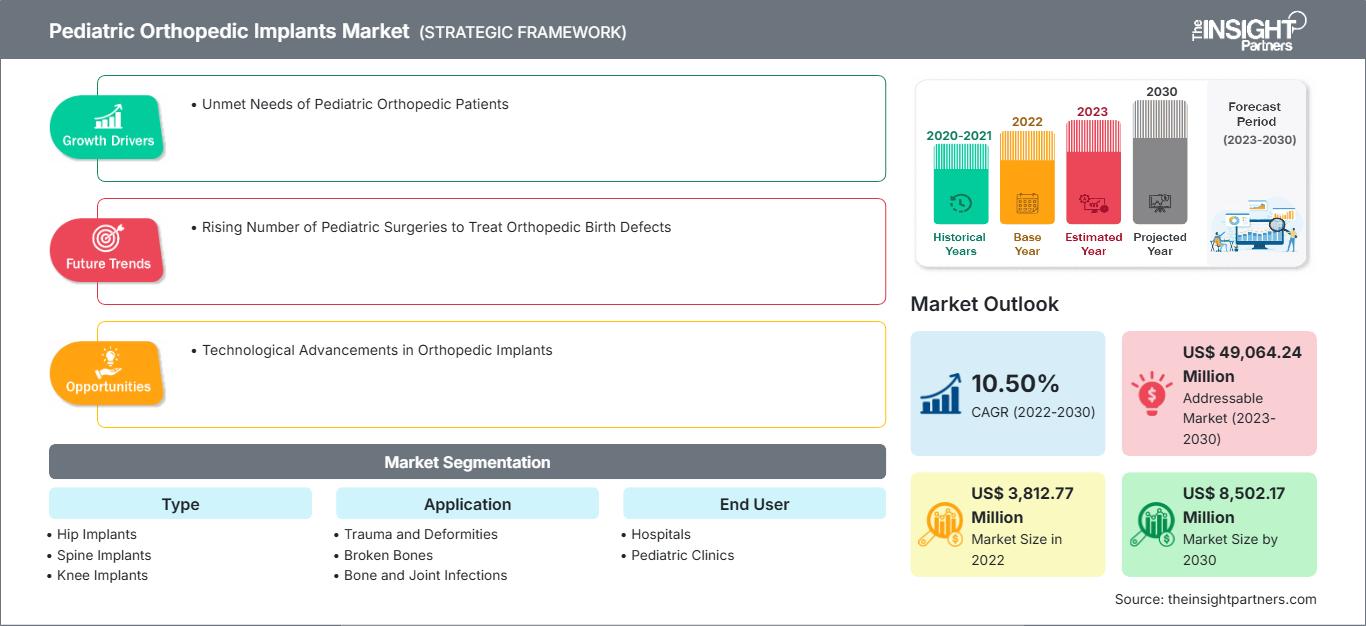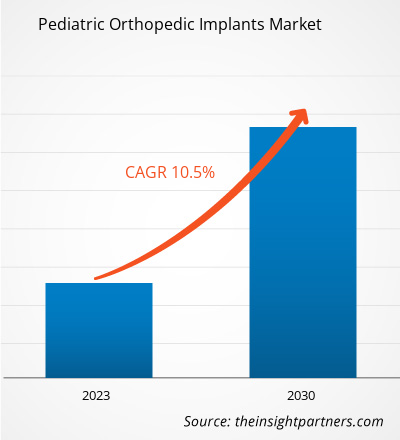儿科骨科植入物市场规模预计将从 2022 年的 38.1277 亿美元增至 2030 年的 85.0217 亿美元。预计该市场在 2022 年至 2030 年期间的复合年增长率将达到 10.50%。骨科植入物的技术进步很可能仍将是市场的主要趋势。
儿科骨科植入物市场分析
骨科植入物是一种医疗器械,用于替换受损或变形的关节、骨骼或软骨,例如因腿部骨折、截肢或先天性缺陷造成的关节、骨骼或软骨。这些装置植入体内,因此它们采用生物相容性的非金属和金属合金制成。骨科植入物可以是永久性的,也可以是用于骨折的暂时性植入物。永久性植入物(例如用于髋关节、膝关节、踝关节、肩关节、肘关节、腕关节和指关节的植入物)旨在终生植入于患者体内,而临时性植入物(例如钢板、螺钉、针、丝和髓内钉)则用于在有限时间内稳定断裂或骨折的骨骼,使其能够愈合。可吸收植入物的使用以及儿科骨科治疗可及性的提高促进了儿科骨科植入物市场的增长。
儿科骨科植入物市场概览
根据BMC Pediatrics于2022年发表的一篇文章,一项研究估计了马拉维16岁或以下儿童肌肉骨骼损伤 (MSI) 的患病率和治疗需求。研究显示,有112,000名儿童需要假肢和矫形器(P&O),42,000名儿童需要助行器,其中包括37,000辆轮椅,73,000名儿童需要药物,59,000名儿童需要物理治疗,20,000名儿童需要骨科手术。
随着儿童肌肉骨骼疾病负担的加重,印度政府一直在实施各种规章制度来规范医疗器械的生产和进口。例如,2022年,印度质量委员会(QCI)与印度医疗器械行业协会(AIMED)和国家认证机构认可委员会(NABCB)合作,启动了印度医疗器械认证(ICMED)计划,这是一项针对印度产品的全新质量保证认证计划。该计划减少了质量认证所需的时间和成本,进一步保障了患者安全,并提升了制造商的信誉和竞争力。这些政府举措有利于印度儿科骨科植入物市场的增长。
自定义此报告以满足您的要求
您将免费获得任何报告的定制,包括本报告的部分内容,或国家级分析、Excel 数据包,以及为初创企业和大学提供超值优惠和折扣
儿童骨科植入物市场: 战略洞察

-
获取本报告的主要市场趋势。这个免费样本将包括数据分析,从市场趋势到估计和预测。
儿童骨科植入物市场驱动因素和机遇
儿科手术数量不断增加,利于市场增长
根据美国疾病控制与预防中心 (CDC) 的数据,马蹄内翻足是美国最常见的出生缺陷之一,2022 年美国约有 6,643 名婴儿受此影响。骨科缺陷是影响肌肉、骨骼和相关组织的先天性异常。发育不良导致髋关节脱位,跖骨内收导致足弯曲或内八字,也被归类为先天性骨科残疾。这些异常主要导致肌肉失衡、瘫痪和下肢感觉减退。因此,骨科出生缺陷患病率的上升推动了儿童骨科植入物市场的增长。
此外,根据2023年5月发表在《Cureus》杂志上的一篇文章,沙特阿拉伯艾卜哈的儿童骨科损伤很常见,尤其是在男孩中。最常见的损伤原因是高处坠落和玩耍相关的损伤。损伤通常是钝性的,包括闭合性骨折。最常见的创伤部位是上肢、头部和下肢。虽然损伤后的住院率很高,但对于大多数病例来说,非手术干预通常就足够了。因此,在预测期内,儿科手术数量的增加将继续使儿科骨科植入物市场受益。
新兴经济体的蓬勃发展带来增长机遇
正如 2021 年 2 月 IEEE Pulse 上发表的文章所强调的那样,在过去几年中,FDA 批准的救生设备中只有 24% 用于儿科,大多数用于 12 岁以上的儿童。不到 4% 适用于 0-2 岁的儿童,而用于新生儿患者的则更少。儿童国家医院正在与 NCC-PDI 合作开发儿科医疗器械并改善这些统计数据。
此外,市场上的主要参与者致力于开发和商业化创新产品和技术,这些产品和技术专门用于满足儿科骨科患者未满足的临床需求并满足骨科医生的需求。这些因素可能会为儿科骨科植入物市场的主要参与者创造重大机遇。
儿科骨科植入物市场报告细分分析
促成儿科骨科植入物市场分析的关键细分领域包括类型、应用和最终用户。
- 儿科骨科植入物市场根据类型细分为髋关节植入物、脊柱植入物、膝关节植入物、牙科植入物、颅颌面植入物等。四价疫苗细分市场在2022年占据了最大的市场份额。
- 根据应用,市场分为创伤和畸形、骨折、骨关节感染、脊柱畸形等。甲型流感病毒细分市场在 2022 年占据了相当大的市场份额。
- 按最终用户划分,市场分为医院、儿科诊所和其他。2022 年,以鸡蛋为基础的细分市场占据了最大的市场份额。
按地域划分的儿科骨科植入物市场份额分析
儿科骨科植入物市场报告的地理范围主要分为五个区域:北美、亚太地区、欧洲、中东和非洲以及南美和中美洲。预计亚太地区未来几年的复合年增长率最高。
北美儿科骨科植入物市场分析基于三个主要国家:美国、加拿大和墨西哥。预计到2022年,美国将在北美儿科骨科植入物市场占据最大份额。美国市场的增长主要得益于骨科手术数量的增加以及提供先进外科服务的诊所数量的增加。根据美国疾病控制与预防中心 (CDC) 的数据,每年约有920万名美国儿童因跌倒和交通事故等意外伤害被送入急诊室。此外,不断增长的产品上市和审批也利好美国市场。
儿科骨科植入物市场区域洞察
The Insight Partners 的分析师已详尽阐述了预测期内影响儿科骨科植入物市场的区域趋势和因素。本节还讨论了北美、欧洲、亚太地区、中东和非洲以及南美和中美洲的儿科骨科植入物市场细分和地域分布。
儿科骨科植入物市场报告范围
| 报告属性 | 细节 |
|---|---|
| 市场规模 2022 | US$ 3,812.77 Million |
| 市场规模 2030 | US$ 8,502.17 Million |
| 全球复合年增长率 (2022 - 2030) | 10.50% |
| 历史数据 | 2020-2021 |
| 预测期 | 2023-2030 |
| 涵盖的领域 |
By 类型
|
| 覆盖地区和国家 |
北美
|
| 市场领导者和主要公司简介 |
|
儿科骨科植入物市场参与者密度:了解其对业务动态的影响
儿童骨科植入物市场正在快速增长,这得益于终端用户需求的不断增长,而这些需求的驱动因素包括消费者偏好的演变、技术进步以及对产品优势的认知度的提升。随着需求的增长,企业正在扩展产品线,不断创新以满足消费者需求,并抓住新兴趋势,从而进一步推动市场增长。

- 获取 儿童骨科植入物市场 主要参与者概述
儿科骨科植入物市场新闻及最新发展
儿科骨科植入物市场评估通过收集来自一手和二手研究的定性和定量数据进行,这些研究包括重要的公司出版物、协会数据和数据库。以下列出了儿科骨科植入物市场的一些发展:
- OrthoPediatrics Corp. 已达成协议收购 Pega Medical,包括其专为成骨不全症和其他骨骼畸形患者设计的 Fassier-Duval 伸缩髓内系统。他们的产品包括用于治疗儿科骨科中一些最独特疾病的新技术。(来源:OrthoPediatrics Corp,新闻稿,2022 年 6 月)
- WISHBONE MEDICAL, INC. 收购了 Back 2 Basics Direct 和 Orbböouml; Surgical 的资产。这是两家私营医疗器械公司,专注于脊柱融合用无菌包装植入物和手术器械的研究、开发和商业化。(来源:WISHBONE MEDICAL, INC,新闻稿,2020 年 4 月)
儿科骨科植入物市场报告内容和交付成果
“儿科骨科植入物市场规模和预测(2020 年-2030 年)”报告对以下领域进行了详细的市场分析:
- 儿童骨科植入物市场规模以及全球、区域和国家/地区范围内所有主要细分市场的预测
- 儿童骨科植入物市场趋势以及市场动态,例如驱动因素、限制因素和关键机遇
- 详细的 PEST/Porter 五力模型和 SWOT 分析
- 儿童骨科植入物市场分析,涵盖主要市场趋势、全球和区域框架、重要参与者、法规和最新市场发展
- 行业格局和竞争分析,涵盖市场集中度、热图分析、知名参与者以及儿童骨科植入物市场的最新发展。
- 详细的公司简介
- 历史分析(2 年)、基准年、预测(7 年)及复合年增长率
- PEST和SWOT分析
- 市场规模、价值/数量 - 全球、区域、国家
- 行业和竞争格局
- Excel 数据集
近期报告
相关报告
客户评价
购买理由
- 明智的决策
- 了解市场动态
- 竞争分析
- 客户洞察
- 市场预测
- 风险规避
- 战略规划
- 投资论证
- 识别新兴市场
- 优化营销策略
- 提升运营效率
- 顺应监管趋势






















 获取免费样品 - 儿童骨科植入物市场
获取免费样品 - 儿童骨科植入物市场